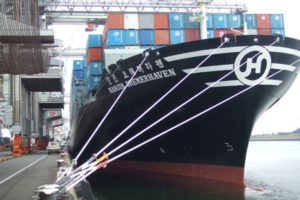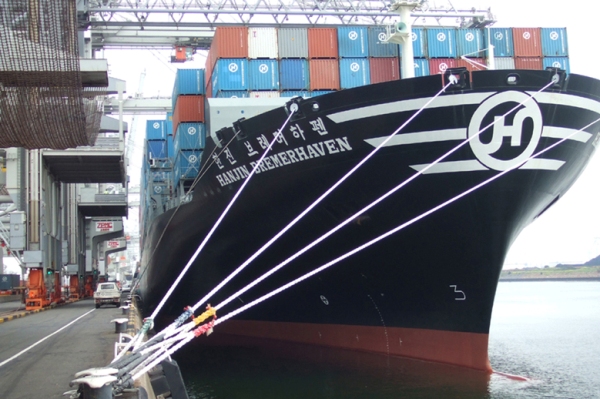 South Korean carrier Hanjin Shipping’s filing for court receivership last week debunks the notion of the invincibility of major container carriers and brings short- and long-term consequences to the industry, according to a new analysis by Drewry.
South Korean carrier Hanjin Shipping’s filing for court receivership last week debunks the notion of the invincibility of major container carriers and brings short- and long-term consequences to the industry, according to a new analysis by Drewry.
The shipping consultancy said the belief that leading box liners will always weather harsh financial storms was strengthened after the industry survived its worst crisis in 2009, when it posted operating losses of nearly US$20 billion and many lines were said to be minutes from bankruptcy, but none died.
“While some smaller players have fallen by the wayside this decade none were remotely in the same league as Hanjin Shipping, which with a containership fleet of around 100 ships and total capacity of 620,000 teu ranks it seventh in the world,” said Drewry.
This complacency had blinded many to the very real possibility of Hanjin’s demise, even though it was open knowledge that the company was in deep financial trouble. From 2010 to the first half of 2016, the company’s operating loss amounted to about $580 million, with most of the damage emanating from the container division, said Drewry.
While the industry overall has been going through tough times, Hanjin, along with compatriot Hyundai Merchant Marine (HMM), was in particularly bad shape, said Drewry, pointing to its Z-score freight operators’ financial stress index which showed low readings for both carriers, indicating a higher risk of bankruptcy.
Since then, HMM has successfully negotiated a huge debt restructuring plan, including obtaining reduced charter rates from ship owners that eventually saw its main creditor, the Korea Development Bank (KDB), become its largest shareholder. The sale of non-core assets also helped HMM report a net income of $185 million in the second quarter, ending a sequence of six quarterly losses. It will join 2M carriers Maersk Line and MSC in a new alliance next April, assuming regulatory approval.
The KDB is also Hanjin’s main creditor, but its self-rescue plan has not proceeded as smoothly as over at HMM. Vessel charterers, most notably Seaspan, refused to lower their rates, and the sale of a number of Hanjin’s assets and the plan to sell two tranches of new shares to sister company Korean Air fell short of raising the sums expected by creditors.
The lack of progress led to Hanjin’s directors calling for court receivership on August 31.
Looking ahead to the organization’s recovery prospects, Drewry is not too optimistic. “While the company is not technically bankrupt during administration it is difficult to see how the company will be able to continue trading as customers are now desperately trying to locate and find alternative ways for their goods to be delivered. It’s unlikely any would entrust their cargoes to Hanjin again,” it said.
Short-term impact
The immediate collateral damage of Hanjin’s situation will be widespread, predicts the maritime research service. Ports and terminals that have recently accepted Hanjin ships and containers will not only lose a customer but might not get paid for work carried out.
Container lessors and charter ship owners, particularly Seaspan and Danaos, which were Hanjin’s biggest suppliers of non-owned ships, are also in trouble. For Danaos, Hanjin’s charter of eight ships accounts for about $560 million of its $2.8 billion contracted revenue, so the Korean firm’s demise would be a serious dent in its income stream.
Even shippers unaffected by Hanjin’s situation will feel a short-term shock as the reduction of capacity will inflate freight rates, noted the shipping consultant. Despite the general rate increases (GRIs) already in place, freight rates out of Asia surged the day after Hanjin’s announcement.
The World Container Index, a joint venture between Drewry and Cleartrade Exchange, reported that spot rates from Shanghai to Los Angeles in the U.S. and Rotterdam in Europe, increased by 42% and 39%, respectively, on September 1 against the previous week.
Meantime, Hanjin’s carrier-partners in the CKYHE Alliance—Cosco, K Line, Yang Ming and Evergreen—who operate a number of services in the East-West container trades and have slots on board Hanjin ships, are facing a big disruption in the wake of the shipping liner’s fall. They will have already started efforts to arrange alternative shipments but there will be inevitable delays, especially for containers stuck on ships denied entry to ports.
As for shippers, those moving boxes away from Hanjin Bills of Lading this week to other carriers will bear additional costs, while terminals will have issues moving boxes to meet a different vessel and uncertainty over who will pay the handling fees.
“This will all be very messy and an additional burden,” said Drewry.
Long-term repercussions
The CKYHE Alliance will have to fill in the gaps caused by Hanjin’s exit, which is likely to disrupt their network scheduling for some months.
Also, Hanjin was due to leave the CKYHE Alliance next year as part of the reshuffling of carriers into new groups and form a new pact with Hapag-Lloyd, K Line, MOL, NYK, and Yang Ming called THE Alliance. Hanjin’s impending exit immediately puts this grouping at a disadvantage, as it will be diminished in size compared to 2M + HMM and the Ocean Alliance of CMA CGM, Cosco, Evergreen, and OOCL.
“Perhaps the most far-reaching consequence of Hanjin’s situation, alongside the recent defensive M&A activity, will be that all stakeholders will now finally understand that carriers cannot survive on a diet of ultra-low freight rates if they want to see healthy competition,” said Drewry. “Soon, shippers will only have 13 carriers that could genuinely be called ‘global’ in scope.”
It added: “The impending bankruptcy of Hanjin should serve as a warning that carriers do have breaking points and that they will not always be rescued. Unless shippers make the altruistic decision to pay more to save carriers (unlikely) they will need to pay more attention to the warning signs.”





